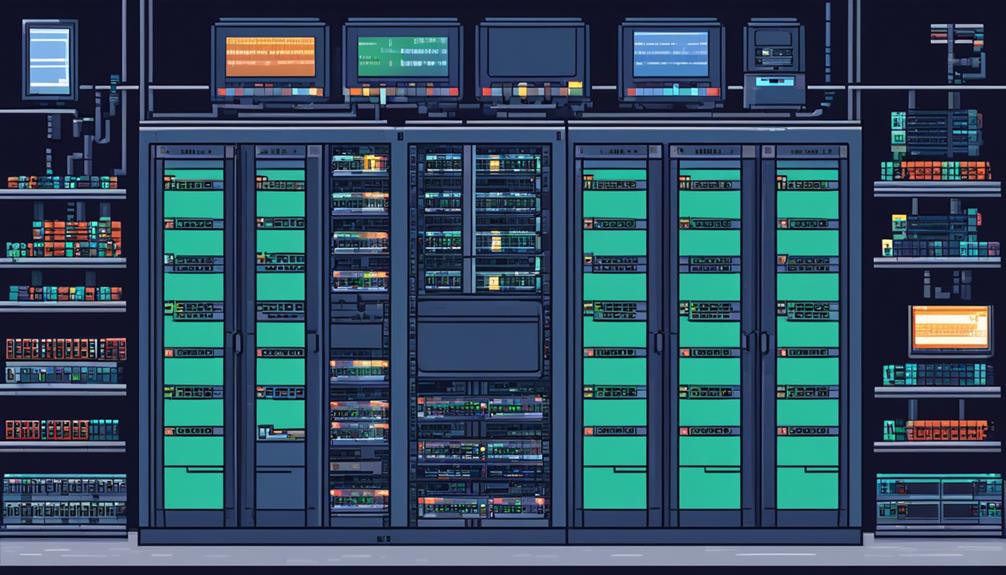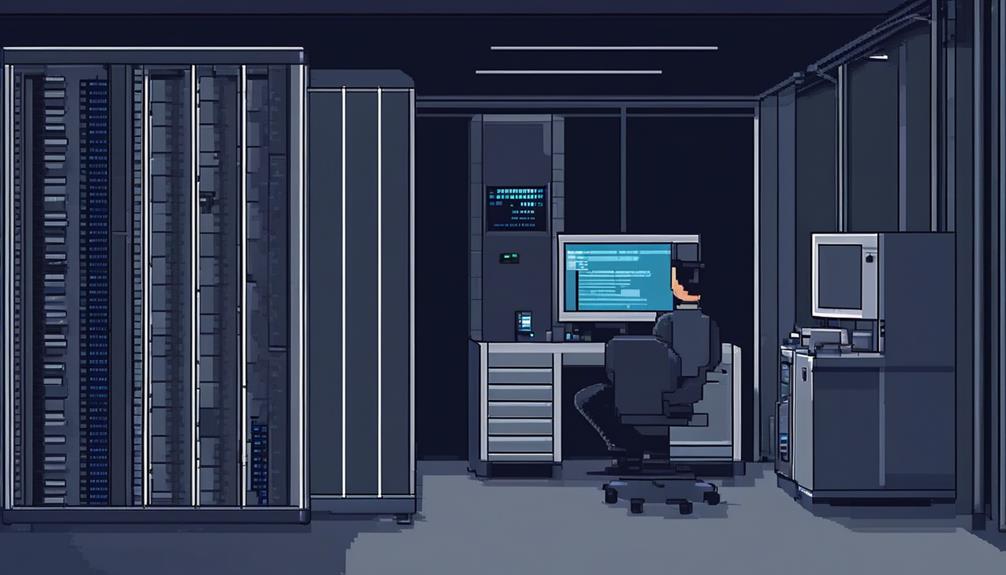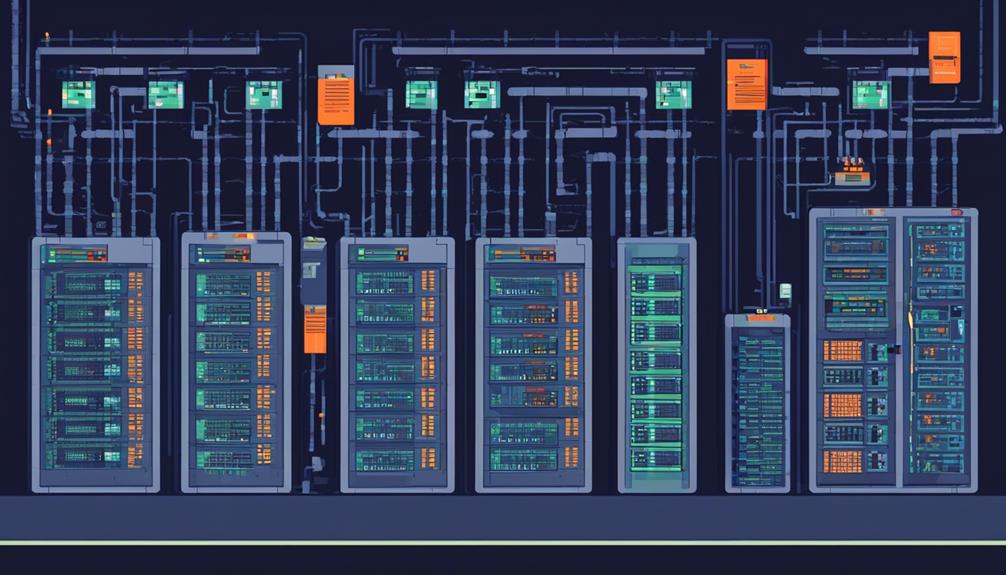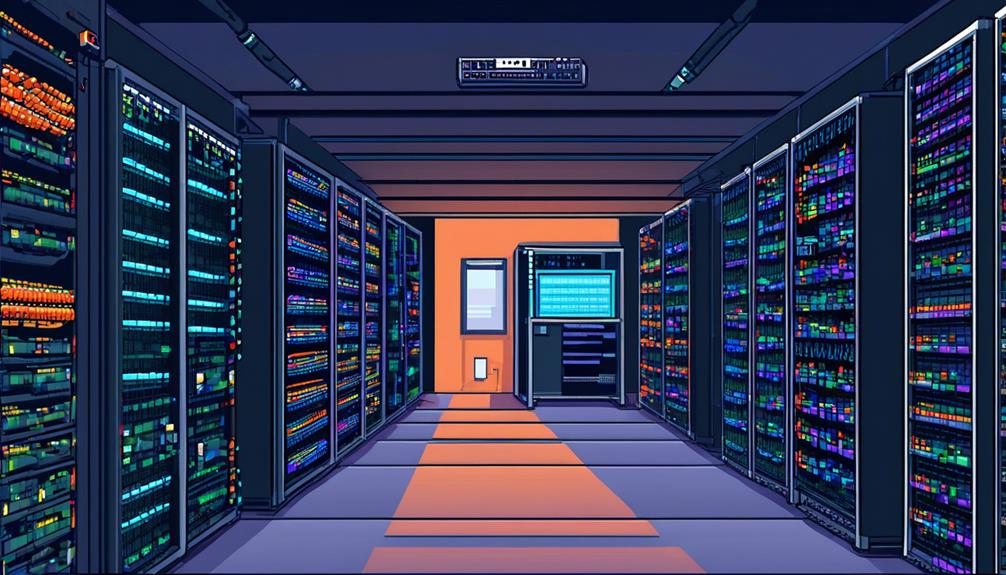Choosing the right location for PBX hardware is a critical decision that can greatly impact the overall functionality and efficiency of a business's communication system. It requires careful consideration of several factors, ranging from the availability of a reliable power supply to the ability to accommodate future growth.
In this discussion, we will explore the key aspects to keep in mind when selecting a suitable location for PBX hardware:
- Accessibility: The location should be easily accessible for maintenance and troubleshooting purposes. It should also be convenient for employees who may need to physically access the PBX hardware.
- Power and network requirements: The location should have a reliable power supply to ensure uninterrupted operation. It should also have proper network connectivity to facilitate communication with other devices and systems.
- Physical security: The PBX hardware should be housed in a secure location to prevent unauthorized access and protect against theft or damage. This may involve implementing security measures such as access control systems, surveillance cameras, and alarm systems.
- Climate control: The location should have adequate climate control to prevent overheating or extreme temperature fluctuations, which can negatively affect the performance and longevity of the PBX hardware.
- Redundancy and backup options: It is important to have backup power supplies and redundancy options in place to minimize downtime in case of power outages or hardware failures.
- Scalability: The chosen location should have the capacity to accommodate future growth and expansion of the PBX system. This includes considering factors such as available space and the ability to add additional hardware or equipment.
- Compliance and regulatory considerations: Depending on the industry and region, there may be specific compliance and regulatory requirements that need to be met. It is important to ensure that the chosen location is compliant with these regulations.
- Cost and budget constraints: The cost of the location and associated infrastructure should be within the budget of the business. It is important to balance the need for a suitable location with the financial constraints of the organization.
By understanding these factors and making informed decisions, businesses can ensure the smooth and uninterrupted operation of their PBX systems.
Key Takeaways
- The location of PBX hardware should be easily accessible for maintenance and troubleshooting, convenient for employees who require physical access, and close to the main office to minimize travel time for IT staff.
- Stable power supply and reliable internet connectivity are crucial for uninterrupted operation, and backup systems like UPS or generators should be in place.
- Physical security measures such as access control, surveillance cameras, and secure equipment storage are important to prevent unauthorized access and protect against theft or tampering.
- Adequate climate control, including temperature regulation and proper ventilation, is necessary to prevent overheating and ensure optimal performance and longevity of the PBX hardware.
Factors to Consider

When choosing a PBX system, there are several factors to consider in order to ensure it meets the specific needs of your business.
One important factor to consider is the right location for the PBX hardware. The location of the PBX hardware can have a significant impact on the performance and functionality of the system.
First and foremost, it is crucial to choose a location that is easily accessible for maintenance and troubleshooting. The hardware should be housed in a secure and controlled environment to prevent unauthorized access and protect it from physical damage. Additionally, the location should have proper ventilation and temperature control to prevent overheating and ensure the longevity of the hardware.
Another factor to consider is the proximity of the PBX hardware to the employees who will be using it. If the majority of employees are located in one office, it may be more practical to have the hardware located on-site. However, if the employees are spread out across multiple locations or work remotely, a cloud-based PBX system would be more suitable. This allows employees to access the system from anywhere with an internet connection, providing flexibility and convenience.
Furthermore, the reliability of the internet connection in the chosen location is crucial for the performance of cloud and IP PBX systems. A stable and high-speed internet connection is necessary to ensure smooth communication and minimize disruptions. It is essential to evaluate the internet service provider and consider backup options in case of any downtime.
Accessibility and Convenience
Considering the importance of easily accessible maintenance and troubleshooting for the PBX hardware, the next factor to discuss is the crucial aspect of accessibility and convenience. When choosing the right location for PBX hardware, it is essential to ensure that the location is easily accessible for maintenance and troubleshooting purposes. This means selecting a location that is convenient for IT staff to access for upgrades and repairs.
One aspect to consider is the proximity of the location to the main office. By selecting a location that is close to the main office, travel time for IT personnel can be minimized, allowing for quicker response times in case of any issues with the PBX hardware. Additionally, accessibility to power and network connections is crucial for the chosen location of PBX hardware. Ensuring that the location has easy access to power sources and network connections will facilitate smooth operations and minimize any disruptions.
Another important consideration is the organization of cable management. Selecting a location that allows for efficient and organized cable management is essential for easy maintenance and future expansions. This includes properly labeling and managing cables, as well as providing adequate space for future expansion needs.
Power and Network Requirements

One of the essential considerations for PBX hardware is ensuring that it meets the power and network requirements specified by the vendor. The location of the PBX hardware plays a crucial role in providing a stable power supply and reliable internet connectivity.
Here are four key points to consider when it comes to power and network requirements for PBX hardware:
- Stable Power Supply: The PBX hardware requires a consistent and uninterrupted power supply to ensure its proper functioning. It is important to have a reliable power source on-site to avoid any downtime or interruptions in communication. This can be achieved by using uninterruptible power supplies (UPS) or backup generators.
- Reliable Internet Connectivity: The PBX hardware relies heavily on internet connectivity to handle voice and data traffic. It is crucial to have a robust network infrastructure in place that can handle the demands of the PBX system. This includes sufficient bandwidth, low latency, and high network availability.
- Backup Systems: Adequate power and network backup systems should be in place to prevent any disruptions in communication. This can include redundant power supplies, backup internet connections, and failover mechanisms. Having backup systems ensures that even in the event of a power outage or network failure, the PBX hardware can continue to operate without any interruptions.
- Vendor Specifications: It is imperative to ensure that the PBX hardware meets the power and network standards specified by the vendor. This ensures compatibility and optimal performance of the equipment. Failure to meet these requirements may result in issues such as hardware failure or degraded call quality.
Physical Security
Physical security for PBX hardware is crucial to safeguard against unauthorized access and potential theft or tampering. Access control measures, such as biometric authentication or key card systems, should be implemented to restrict entry to authorized personnel only.
Surveillance and monitoring systems, including surveillance cameras and security personnel, should be in place to monitor the physical environment and detect any suspicious activities.
Additionally, secure equipment storage with locking mechanisms should be utilized to protect the PBX hardware from physical damage or theft.
Access Control Measures
Utilize physical security measures, such as biometric scanners or key card entry systems, to restrict access to PBX hardware and ensure its protection. By implementing these access control measures, you can safeguard the PBX hardware from unauthorized personnel and potential security breaches.
Here are four important considerations when it comes to access control measures for PBX hardware:
- Secure PBX hardware in a locked server room or cabinet to prevent unauthorized access.
- Utilize surveillance cameras to monitor and record access to PBX hardware locations.
- Implement strict access control policies and procedures for employees and visitors entering PBX hardware areas.
- Conduct regular audits and inspections of physical security measures to ensure they remain effective in protecting PBX hardware.
Surveillance and Monitoring
To ensure the utmost security, it is essential to implement surveillance and monitoring techniques for physical premises when choosing the right location for PBX hardware.
Surveillance cameras play a vital role in monitoring the surroundings of the on-premise PBX system. These cameras should be strategically placed to cover all critical areas, including entryways, server rooms, and equipment storage areas.
Motion sensors and alarms can also be employed to detect any unauthorized access or suspicious activity.
It is recommended to have security personnel on-site for real-time monitoring and response.
Additionally, access control systems, such as biometric authentication, should be installed to restrict access to sensitive areas.
Implementing comprehensive surveillance and monitoring measures ensures the protection of the phone system and the physical security of the PBX systems.
Secure Equipment Storage
When considering the security of the PBX hardware, one crucial aspect to address is the secure storage of the equipment in a locked and monitored room. This ensures that unauthorized individuals cannot gain access to the sensitive PBX systems.
To further enhance the security, the following measures can be implemented:
- Access control systems: By using keypads or biometric scanners, entry to the PBX equipment storage area can be restricted, allowing only authorized personnel to enter.
- Security cameras: Installing surveillance cameras in the storage area helps monitor and deter potential intruders, providing an additional layer of protection.
- Environmental controls: Implementing temperature and humidity monitoring systems ensures optimal performance and longevity of the PBX hardware.
- Secure racks or cabinets: Using specially designed racks or cabinets can physically safeguard the PBX equipment, preventing tampering or theft.
Climate Control
Proper climate control is imperative for maintaining the optimal operating conditions of PBX hardware and preventing potential damage and malfunctions. PBX hardware generates heat during operation, and if not properly regulated, this heat can accumulate and cause overheating, leading to system failures and reduced performance. Additionally, humidity levels must be carefully controlled to prevent corrosion and electrical malfunctions. Choosing the right location for PBX hardware involves considering climate control as a critical factor to ensure the longevity and reliability of the equipment.
To illustrate the importance of climate control in selecting the location for PBX hardware, the following table provides an overview of the recommended temperature and humidity ranges for optimal operation:
| Climate Parameter | Recommended Range |
|---|---|
| Temperature | 64°F – 77°F (18°C – 25°C) |
| Humidity | 40% – 60% |
Maintaining these climate parameters is crucial for the efficient functioning of PBX hardware. Deviating from the recommended ranges can result in adverse effects on the equipment's performance and lifespan. High temperatures can accelerate component wear and increase the risk of hardware failure, while high humidity levels can lead to condensation, which may cause short circuits and other electrical issues.
When choosing a location for PBX hardware, it is essential to consider the existing climate control infrastructure. If the location lacks adequate climate control measures, such as proper ventilation or air conditioning, additional investments may be required to ensure the equipment's optimal operating conditions. Moreover, regular monitoring and maintenance of the climate control parameters should be implemented to promptly address any deviations and prevent potential damage to the PBX hardware.
Noise and Interference

Noise and interference are significant factors to consider when choosing the location for PBX hardware. Acoustic considerations include minimizing background noise and ensuring sound insulation, while electromagnetic interference can be caused by nearby electrical equipment or radio frequency interference.
To maintain the reliability and clarity of PBX connectivity, it is crucial to select a location with minimal noise and interference, and to implement proper shielding and grounding measures.
Acoustic Considerations
To ensure optimal call quality, it is crucial to carefully evaluate the acoustic conditions of the chosen location for the PBX hardware, taking into account potential sources of interference and external noise pollution. Here are some important acoustic considerations when choosing the right location for your PBX hardware:
- Proximity to potential sources of interference: Consider the distance between the PBX hardware and any electrical equipment or machinery that could generate electromagnetic interference (EMI) or radio frequency interference (RFI). Keeping the PBX hardware away from these sources can help minimize interference and improve call quality.
- Evaluating the acoustics of the location: Assess the ambient background noise levels in the chosen location. High levels of background noise can negatively impact communication clarity. Choosing a location with low background noise or implementing soundproofing measures can help ensure clear communication.
- External noise pollution: Consider the potential for external noise pollution, such as traffic noise or nearby construction. These external factors can add unwanted noise to the communication and affect call quality. Selecting a location away from these sources or implementing additional soundproofing measures can help mitigate their impact.
- Dedicated space for PBX hardware: Consider creating a dedicated space for the PBX hardware to further minimize acoustic considerations. This can involve isolating the hardware in a separate room or enclosure to reduce the impact of external noise and interference.
Electromagnetic Interference
When considering the acoustic conditions of the chosen location for PBX hardware, it is crucial to address the potential sources of electromagnetic interference (EMI) and radio frequency interference (RFI) to ensure optimal call quality.
Electromagnetic interference can disrupt PBX systems, leading to distorted or dropped calls. Sources of electromagnetic interference can include nearby power lines, electrical equipment, and wireless devices.
To minimize the effects of electromagnetic interference, proper grounding and shielding of PBX hardware should be implemented. Additionally, using twisted pair cables and keeping them away from sources of interference can help reduce the impact of electromagnetic interference.
Regular maintenance and monitoring of PBX hardware are also important to promptly detect and address any electromagnetic interference issues that may arise.
It is essential to choose a location for PBX hardware that minimizes the potential for electromagnetic interference to ensure reliable and high-quality communication.
Space and Rack Requirements
The dimensions and weight of the PBX hardware components should be carefully considered when selecting an appropriate rack and space for installation. PBX systems consist of various hardware components that need to be housed in a suitable location to ensure optimal performance and longevity. Here are some important factors to consider when determining the space and rack requirements for PBX hardware:
- Size and Number of Components: The size and number of PBX hardware components will determine the amount of space required. It is essential to accurately measure the dimensions of each component and calculate the total space needed to accommodate them.
- Ventilation and Cooling: Adequate ventilation and cooling systems are crucial to prevent overheating of the PBX equipment. Ensure that the chosen location has proper airflow and cooling mechanisms to maintain optimal operating temperatures.
- Power Outlets and Backup Options: The selected location should have sufficient power outlets to support the PBX hardware. Additionally, it is important to consider backup power options, such as uninterruptible power supplies (UPS), to ensure continuous operation during power outages.
- Future Expansion: When selecting a location and rack for PBX hardware, it is essential to plan for future expansion. Consider choosing a rack that can accommodate additional hardware components as your business grows and communication needs increase.
Taking these factors into account when determining the space and rack requirements for PBX hardware will ensure a well-organized and efficient installation. It is crucial to provide the necessary space, ventilation, power supply, and room for future expansion to maximize the performance and lifespan of your PBX system.
Redundancy and Backup Options

Implementing redundancy options and backup measures is crucial for ensuring uninterrupted operation of the PBX system, even in the event of failures or disruptions. When choosing a PBX system, it is important to consider the available redundancy and backup options to minimize downtime and maintain seamless communication.
One of the key redundancy options to consider is backup power supplies. Having a backup power source, such as uninterruptible power supplies (UPS), ensures that the PBX system remains operational even during power outages. This helps to prevent any disruptions in communication and ensures continuous availability.
In addition to backup power supplies, it is essential to have redundant hardware in place. Redundant hardware refers to having duplicate components, such as servers or switches, that can take over in the event of a failure. This can be achieved through the use of hot-swappable components or failover systems that automatically switch to redundant hardware when needed.
Another backup option to consider is off-site data backups. Storing PBX system data off-site ensures that even if there is a hardware or software failure, the data can be easily restored, minimizing any potential data loss and downtime.
Cloud-based PBX solutions offer inherent redundancy and backup features. By utilizing cloud-based servers, the PBX system is spread across multiple data centers, ensuring that even if one server goes down, the system remains operational. This eliminates the need for on-premise hardware and reduces upfront costs.
Lastly, employing redundant internet connections and network paths is vital to ensure connectivity and prevent disruptions to PBX operations. Having multiple internet connections, from different service providers or using different technologies, helps to maintain uninterrupted communication even if one connection fails.
Scalability and Future Expansion
To ensure a seamless and efficient expansion process, it is crucial to prioritize scalability and future expansion capabilities when selecting a PBX system. As businesses grow and evolve, their communication needs change, necessitating the ability to accommodate additional users and features.
When considering PBX hardware location, it is important to keep the following factors in mind:
- Scalability: Look for a PBX vendor that supports business growth and can scale the system to meet future expansion needs. The system should be able to handle an increasing number of users and offer the flexibility to add new features as required.
- Future expansion: Inquire about the vendor's scalability capabilities and their ability to handle the addition of phone setups for new hires. The system should have the capacity to adapt to the evolving needs of the business without causing disruptions or downtime.
- Minimal downtime: When expanding the PBX system, it is essential to select a vendor with expertise in minimizing downtime. This ensures that the business can continue its operations smoothly during the expansion process, without any significant disruptions to agent productivity.
- Consultation and support: Consider seeking expert consultation on expanding contact centers, such as offerings from LiveVox. Their expertise can help ensure a smooth and efficient expansion process, providing guidance on best practices and minimizing potential challenges.
Compliance and Regulatory Considerations

Considerations surrounding compliance and regulatory requirements play a critical role in determining the appropriate location for PBX hardware. The chosen location must adhere to legal and regulatory requirements for data protection and privacy. This is especially important in industries such as healthcare, where compliance with regulations like HIPAA is essential, or for businesses operating in the European Union, where adherence to the General Data Protection Regulation (GDPR) is mandatory.
When choosing a location for PBX hardware, it is crucial to consider any local, state, or national regulations regarding telecommunications and data storage. These regulations may include requirements for data encryption, backup and recovery procedures, and physical security measures. Failure to comply with these regulations can result in significant legal and financial consequences for the organization.
Ensuring that the chosen location meets compliance standards is vital for mitigating risks. Non-compliance can lead to data breaches, fines, and reputational damage. It is essential to conduct a thorough assessment of the regulatory landscape and identify any specific compliance requirements that apply to the organization.
In addition to legal and regulatory considerations, organizations should also consider the location's proximity to their customers and business operations. This can help ensure efficient communication and minimize latency issues. Furthermore, organizations should assess the infrastructure and connectivity options available at the chosen location to ensure they meet the requirements of their PBX hardware.
Cost and Budget Constraints
When evaluating PBX hardware options, it is crucial to carefully consider the cost and budget constraints associated with the initial investment and ongoing maintenance. Making the right choice can significantly impact your business's financial health and long-term success.
Here are four key factors to consider:
- Scalability: Assess the scalability of the PBX hardware to determine if it can accommodate your business growth without requiring substantial additional expenditure. Look for systems that offer the flexibility to add or remove extensions easily, ensuring that you only pay for what you need.
- Cost-saving features: Evaluate the potential for cost savings through features such as virtual extensions and remote management capabilities. Virtual extensions allow employees to connect their mobile devices to the PBX system, eliminating the need for additional hardware costs. Remote management capabilities enable efficient troubleshooting and maintenance, reducing the need for costly on-site visits.
- Flexible pricing options: Look for PBX hardware solutions that offer flexible pricing options, such as subscription models or pay-as-you-go plans. These alternatives allow you to align your expenses with your budget constraints, providing greater financial flexibility.
- Cloud-based solutions: Explore the potential for cost-effectiveness through cloud-based PBX hardware. Cloud-based systems eliminate the need for significant upfront hardware expenses and ongoing maintenance. Instead, you pay a predictable monthly fee, making it easier to manage your budget.
Frequently Asked Questions
Is PBX Obsolete?
The future of telephony lies in hosted solutions, which offer numerous advantages over traditional PBX systems. Hosted solutions eliminate the need for physical hardware, allowing for greater flexibility and scalability.
Alternatives to PBX systems include cloud-based VoIP solutions, which leverage the power of internet connectivity to provide seamless communication.
Transitioning from traditional PBX to modern solutions is essential for businesses looking to optimize their telephony infrastructure and take advantage of the benefits offered by VoIP technology.
How Do I Setup a PBX at Home?
Setting up a PBX system at home requires careful planning and consideration.
First, consider the benefits of using a hosted PBX system, such as cost savings and scalability.
Next, follow a step-by-step guide to set up the PBX, including selecting the right hardware, configuring the system, and connecting the necessary cables.
Common challenges may include network compatibility and troubleshooting issues.
To secure your home PBX network, implement strong passwords and regularly update the system.
Lastly, familiarize yourself with troubleshooting tips to address common issues that may arise during setup.
What Are the Three Main Components of the Pbx?
The three main components of a PBX system are the central unit, telephone sets, and outside lines.
The central unit serves as the core of the PBX, handling call switching, routing, and all features and services.
Telephone sets, or extensions, are used by users to make and receive calls within the PBX system.
Outside lines are connections to the public switched telephone network (PSTN) that allow users to make calls outside the organization.
These components are essential for PBX hardware installation, system configuration, maintenance, troubleshooting, integration with other communication systems, and scalability and expansion options.
What Is the Difference Between Cloud and Local Pbx?
Cloud PBX and Local PBX offer distinct advantages and considerations.
Cloud PBX provides the flexibility of low initial costs, easy setup, and scalability, making it suitable for businesses with remote workers. However, it relies on a stable internet connection and may lack certain advanced features.
On the other hand, Local PBX offers complete control, customization options, and is ideal for businesses not requiring advanced features or with limited internet access.
The choice between the two depends on factors like cost comparison, implementation process, security measures, and scalability options.
